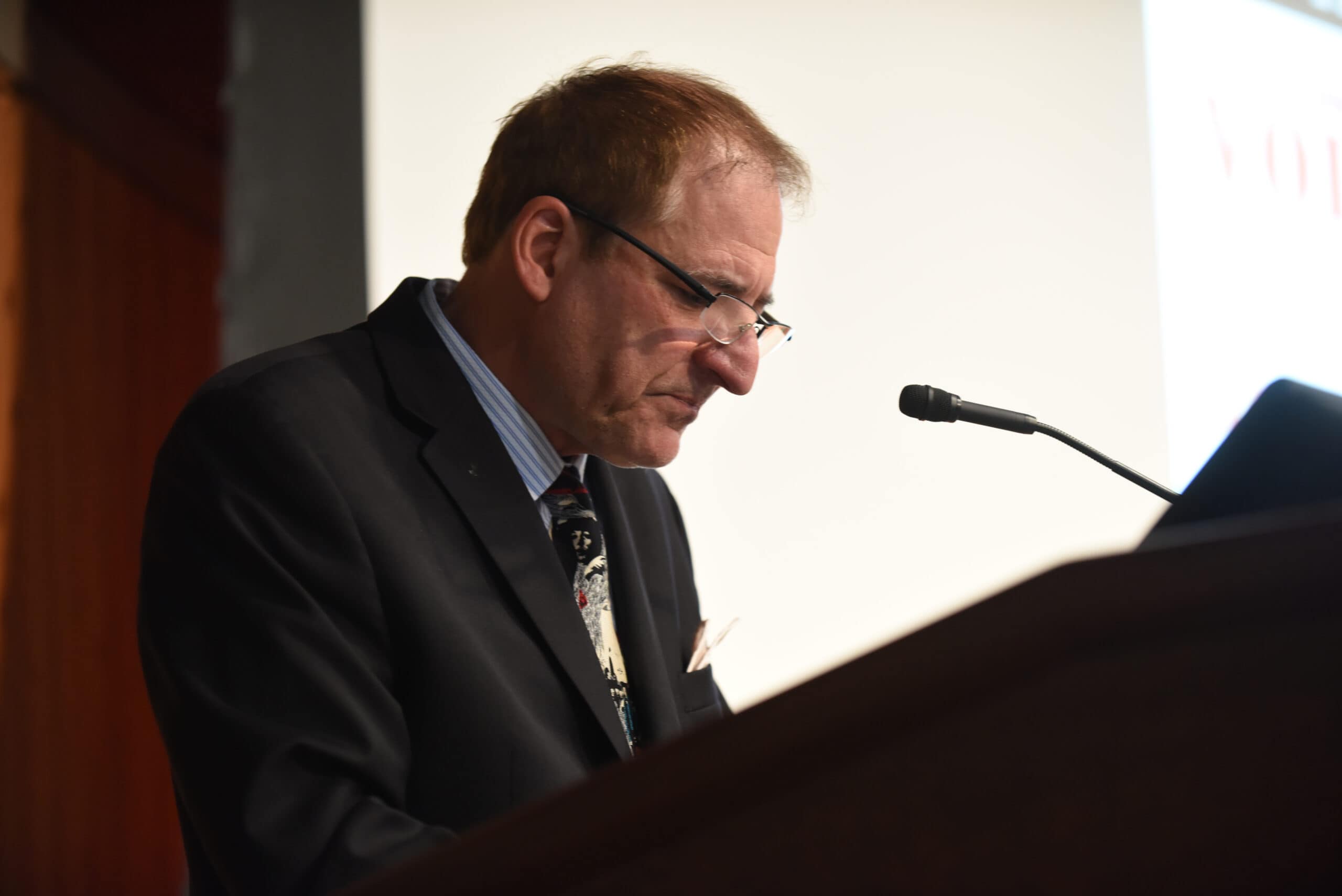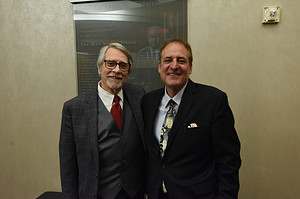View Larger Image

Andrew Farah, M.D., discusses the medical and psychological influences that affected Hemingway.
Image by John Paul Jones
Author of ‘Hemingway’s Brain’ Discusses Forces that Led to Ernest Hemingway’s Suicide
| | A forensic psychiatrist who spent 17 years studying Ernest Hemingway presented a detailed look at the neurological and mental health issues that contributed to American writer and journalist’s suicide.
The Nobel Prize-winning author was found dead July 2, 1961, of a self-inflicted gunshot wound to his head at his home in Ketchum, Idaho, where he lived with his wife, Mary. She reported being asleep upstairs when the gunshot rang out from the foyer of the home.
As the inaugural speaker for a new History of Medicine and Science lecture series at the University of Arkansas for Medical Sciences (UAMS), B. Andrew Farah, M.D., discussed information he uncovered while conducting research for his book, “Hemingway’s Brain.” Farah’s lecture was called “Hemingway’s Demise – the Facets of Our Roughest Diamond.”
Speaking from the Fred Smith Auditorium at the Jackson T. Stephens Spine & Neurosciences Institute on April 28, the North Carolina psychiatrist and author noted that Hemingway died just six days after being discharged from the Mayo Clinic in Rochester, Minnesota, after treatment for severe depression and psychosis.
Farah said much of Hemingway’s 61 years were spent in the company of people who were depressed, alcoholics or both; and that a series of head injuries he suffered as a result of car crashes, two plane crashes, other accidents, boxing matches and playing football — some of which caused concussions that were never treated — left him with what is now recognized as chronic traumatic encephlopathy (CTE). He added that Hemingway had symptoms of mental illness such as bipolar disorder and narcissistic personality traits, as well as a number of serious physical ailments.
Adding to those difficulties was a tendency to self-treat by drinking and through his writing, Farah said.
“This is how he processed everything in his life,” Farah said, referring to the writing.
Farah said the famous novelist was also genetically predisposed to suicide, as evidenced by the suicide of his father in 1928 at the age of 57, as well as the deaths of two of his sisters and, in 1996, the overdose death of his granddaughter, actress and model Margaux Hemingway, at age 42.
The subject of Hemingway’s father’s death seemed to weigh heavy on his mind, as it cropped up in various short stories he wrote as well as the novel “For Whom the Bell Tolls,” Farah said.
The psychiatrist spent a substantial part of the lecture discussing Hemingway’s friendships over the years with other well-known writers who were overwhelmed by mental health disorders, such as Hemingway’s best friend, author James Joyce. Farah called Joyce a “functional alcoholic,” and said another good friend of Hemingway’s, F. Scott Fitzgerald, was “a much less functional alcoholic” than Hemingway.
Hemingway’s other friends were the poet T.S. Eliot, whose wife’s “histrionics” were mistreated with bromide, at what is now known to be five times the toxic dose, and poet Ezra Pound, whose life, Farah said, was proof that “Hemingway did not have a monopoly on these issues.”
Farah said that Pound, who spent 13 years in a hospital for the criminally insane, “was really misunderstood. He’s kind of like the eternal Rorschach Test.”
Another friend, poet Hart Crane, experienced “kind of an accelerated version of Hemingway’s demise” when he jumped off a ship and killed himself at age 32 after several previous suicidal threats.
The psychiatrist played a video recording in which Hemingway stumbled slowly through an interview with a television reporter not long after surviving two plane crashes, as proof that the author suffered from traumatic brain injury.
In questions after his talk, Farah said he believed that Hemingway was at some point aware of his cognitive decline, which was likely accelerated by a blast-wave concussion injury many years earlier that sheared neurons in his brain.
Asked if he was mentally ill before his series of head injuries, Farah replied, “He was narcissistic. He recognized his genius.”
“Hemingway was a complex and enigmatic figure, whose writing style and life experiences continue to capture scholars and readers,” said T. Glenn Pait, M.D., director of the Spine & Neurosciences Institute. “Through Dr. Andrew Farah’s engaging presentation, the audience gained a deeper understanding of the literary and personal influences that shaped Hemingway’s legacy.”

